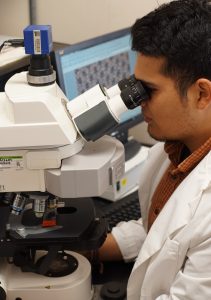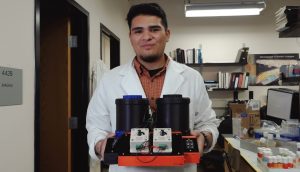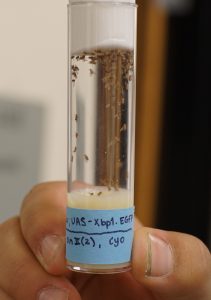DATE: 12/01/2019
WRITER: Vladimir Avina, 575-646-7234,
vlad23@nmsu.eduCONTACT: Aggie Innovation Space, 575-646-3591,
innovate@nmsu.eduCONTACT: Luke Sanchez,
lukes3@nmsu.edu
 |
| Luke Sanchez, a biology major and student regent at New Mexico State University, is using flies to study degeneration in eyes with the help of student engineers from the Aggie Innovation Space. Sanchez uses high-powered microscopes to look at fly eye samples. (NMSU Photo by Vladimir Avina) |
Biology researchers at New Mexico State University are using flies to study degeneration of human eyesight with the help of student engineers from the Aggie Innovation Space.
Luke Sanchez, a biology major and student regent at NMSU, is working with a team of biologists under the supervision of Jennifer Curtiss in the Drosophila (fruit fly) Research Lab. The team seeks to better understand the effects of environmental stress on eye structure and function using flies as a model.
The types of stress Sanchez has found to cause degeneration in the eye include overnutrition and constant light exposure, particularly blue light, which is commonly emitted by phones and digital screens.
“By understanding how these processes work mechanistically and genetically in flies, it can tell us a lot about how to maintain and preserve the human eye,” Sanchez said.
But experiments for Sanchez’s research called for expensive equipment. He needed a specialized machine that could hold a glass vile containing flies without interaction from ambient light.
“The anticipated cost was anywhere from $700 to $1,200,” Sanchez said. “I looked for answers within the NMSU, and a really good friend of mine who works at the Innovation Space advised me to show them the designs to see what they could do.”
Innovators, student employees at AIS, built a manual version of the machine. It has manual controls for red and blue LED lights, 3D-printed cylinders and lids to cover ambient light, Arduino circuits and a frame holding it all together.
The machine plays a key role in gathering the data needed to study fruit fly eyes. The cylinders have LED strips fixed on the inside that hold a small vial, which contains flies with the specific food that group of flies are fed.
 |
| Luke Sanchez, a biology major and student regent at New Mexico State University, is using flies to study degeneration in eyes with the help of student engineers from the Aggie Innovation Space. Sanchez holds the machine developed by AIS Innovators. (NMSU Photo by Vladimir Avina) |
“What I got from the Aggie Innovation Space was so much more than I expected,” Sanchez said. “They took the time to get familiar with the things they didn’t know in order to build the machine in the best way possible.”
AIS is open to all current NMSU students. The shop assists with everything from 3D printing prototypes to programmable development boards such as Galileo, Arduino and Raspberry Pi, a credit card-sized computer.
Diego Chavez, a dual-major student in aerospace and mechanical engineering, is one of the Innovators who brought the project to life.
“It was an amazing experience being able to develop research tools for other departments with applied engineering knowledge,” Chavez said.
Aside from working with Sanchez, AIS is assisting with projects from multiple departments in the College of Arts and Sciences.
“This serves as a great example for possible interactions between engineering and other departments on campus to find innovative research solutions,” Lakshmi Reddi, dean of the College of Engineering said. “The Aggie Innovation Space, indeed, provides an exciting opportunity where researchers, engineers and non-engineers can work together.”
“Working with (AIS) over the course of this semester made me realize how awesome it was to bring the perspective of an engineer into the mindset of a biologist and the perspective of a biologist into the mindset of an engineer,” Sanchez said.
Before taking his project to AIS, Sanchez said carrying out the experiments was time-consuming.
 |
| Luke Sanchez, a biology major and student regent at New Mexico State University, is using flies to study degeneration in eyes with the help of student engineers from the Aggie Innovation Space. These fruit flies are on a high-fat diet in order for researchers to better understand overnutrition and eye degeneration. (NMSU Photo by Vladimir Avina) |
“Previously, I was exposing these flies to ambient light, and I found it took about five to seven days or even longer to induce the type of eye degeneration I need to find answers to the questions I want to ask,” Sanchez said. “With this blue light machine, I’m able to induce that kind of degeneration in eight hours and sometimes even greater degeneration in just a little bit more time.”
Sanchez explained fruit flies have similar genetic code to humans. He said 75 percent of fruit fly genes are homologous, genes inherited in two species by a common ancestor, with human genes. Sanchez is studying is a process called phototransduction, the process in which eyes accept light, turns it into an electrical impulse and sends the impulse to the parts of the brain that creates an image. Along with this, the flies are put on different diets to study degeneration in their eyes.
“Some of the flies go in the dark, some of them go on 12-hour dark and light cycles and some of the flies go on these constant light apparatuses that we made,” Sanchez said. “We put flies on a 4.5 percent concentration of high-fat diet and also on a high-concentration of high-sugar diets, and we were able to show really significant rates of retinal degeneration were happening.”
The goal of Sanchez’s research is to take the idea of overnutrition and its impact on eyes one step further. He said this could be valuable information to people who are predisposed to certain eye conditions like macular degeneration or diabetic retinopathy.
“Now that we know that certain types of saturating diets can affect the structure and functions of the eye, we want to know mechanically exactly what is happening,” Sanchez said. “I’m actually already working with the Innovators to optimize this machine to put more flies and bigger experiments. I think as we work together, we’re only going to make this machine better and better and more functional.”


